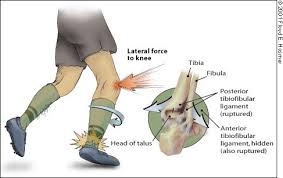Ankle Syndesmosis Injury Part 2
Syndesmosis injuries are amongst the most severe sprains of the foot and ankle. Initially they are very painful and often make it impossible to take weight through the leg or continue normal activity.
Pain and Symptoms
Syndesmosis injuries are amongst the most severe sprains of the foot and ankle. Initially they are very painful and often make it impossible to take weight through the leg or continue normal activity.
Mild to moderate sprains may initially mimic a common sprained ankle. Symptoms include pain and swelling on the outside, front and above the ankle. Pain may radiate upward along the side of the lower leg. Although ankle syndesmosis injuries comprise less than 10% percent of all ankle injuries, they are such important structures that they require urgent assessment and treatment. It is vital to remember that an ankle syndesmosis injury is more complex than a simple ankle sprain. The healing time is typically longer, and returning to normal activity is usually a more gradual process.
Diagnosis
The diagnosis of syndesmosis injuries is usually made by examining the ankle. If an injury is suspected, an X-Ray or MRI assessment is often required to determine the extent of the injury and to see if other injuries such as fracture have occurred.
Treatment
Treatment of a syndesmotic injury will vary according to the severity and site of the injury. Severe injuries will require surgery while minor and moderate injuries can be treated successfully with Physiotherapy, including rehabilitation exercises. In all cases a qualified Physiotherapist should guide the rehabilitation process and in many cases an Orthopaedic Surgeon needs to be consulted.

